|
 Russula albolutescens Russula albolutescens
BiostatusPresent in region - Indigenous. Endemic
Images (click to enlarge)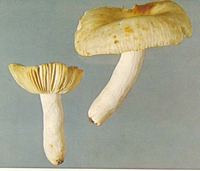
Caption: Fig. 33 - Russula albolutescens (x 3/4). | 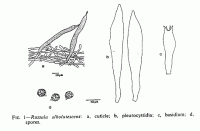 | 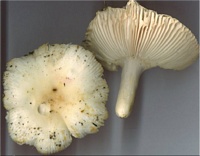
Owner: P. Leonard | 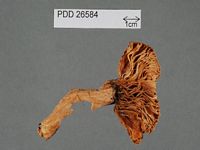
Caption: Dried type specimen
Owner: Herb PDD | 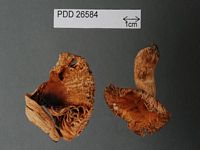
Caption: Dried type specimen
Owner: Herb PDD |
Article: McNabb, R.F.R. (1973). Russulaceae of New Zealand. 2. Russula Pers. ex S.F. Gray. New Zealand Journal of Botany 11(4): 673-730 (http://www.rsnz.org/publish/abstracts.php).
Description: pileus: 4-7.5 cm diam., convex when young, centrally depressed at maturity, viscid, glabrous, velar remnants absent, white, pallid creamy white, cream, or pallid yellowish white, often stained ochraceous brown. Margins thin, faintly to conspicuously pectinate for 0.7-1.5 cm. Cuticle 125-175 µm thick, composed of repent or ascending, interwoven hyphae and pilocystidia; hyphae thin-walled, septate, 1.5-4 µm diam., terminal cells unspecialised; pilocystidia mainly superficial, projecting, ± fusiform, thin-walled, contents refractive in KOH, 40-75 X 4.5-7.5 µm. lamellae: adnate to subdecurrent, moderately crowded, moderately thick, simple or forked near stipe, to 8 mm deep, pallid creamy white to pallid cream, not discoloured at maturity, lamellulae rare. stipe: 3.5-6 cm long, ± equal, 1-1.5 cm diam., chambered at maturity, dry, glabrous, innately longitudinally fibrillose under lens, white to pallid creamy white, often stained pallid yellowish brown; flesh white, unchanging on exposure to air. Cuticle composed of interwoven hyphae 1.5-4 µm diam., terminal cells projecting obliquely; caulocystidia mainly superficial, projecting, similar to pilocystidia. spores: Spore print pallid creamy white; spores broadly elliptical, obliquely apiculate; apiculus to 1.5 µm long, 7-9 X 6-7.5 µm, ornamentation moderately dense, of fine amyloid verrucae to 0.5 µm high, joined by fine to moderately fine amyloid ridges and forming a partial reticulum, or occasionally isolated; plage indistinct. hymenium: basidia hyaline, clavate, 32-50 X 8-10.5 µm, 4-spored, sterigmata to 7 µm long; pleurocystidia scattered, numerous, fusiform, hyaline, thin-walled, contents refractive in KOH, often projecting to 25 µm beyond basidia, apices acuminate, strangulate, or capitulate, 56-110 X 8-12 µm, cheilocystidia sparse, similar to pleurocystidia but shorter. hymenophoral trama: heteromerous, intermixed, oleiferous hyphae present. context of pileus: White, unchanging; structure heteromerous, clamp connections absent. taste: lamellae and context mild, chemical characters: formalin on context—n.r.; phenol on context—slowly deep vinaceous; FeSO4 on context—rapidly salmon pink; guaiacol on stipe base—rapidly faint pink; KOH on pileus—darkening; on context—n.r.; NH4OH on pileus and context—n.r.
Habitat: Solitary or in pairs under Leptospermum.
Notes: This species probably can be classified in section Ingratae Quel. subsection Foetentinae Melzer & Zvara of Singer (1962).
|